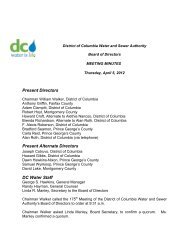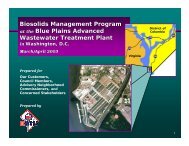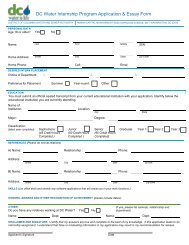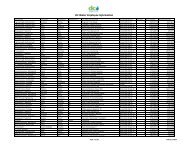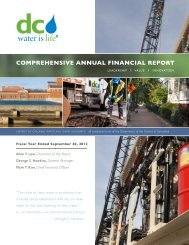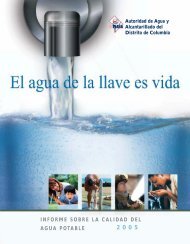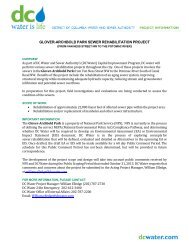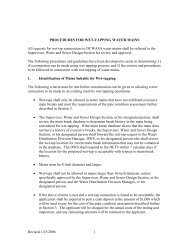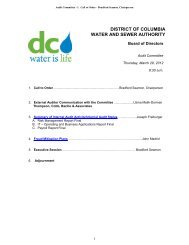2008 Annual Report - DC Water
2008 Annual Report - DC Water
2008 Annual Report - DC Water
You also want an ePaper? Increase the reach of your titles
YUMPU automatically turns print PDFs into web optimized ePapers that Google loves.
Sewer inspection and design activity<br />
in FY <strong>2008</strong> included the following projects:<br />
•yA detailed analysis of the sewer system in Northeast<br />
Washington, using remote closed-circuit video<br />
equipment, resulted in a plan to install new manholes<br />
for better access, remove heavy root intrusion into the<br />
sewer and repair cracks.<br />
•yA similar detailed investigation was conducted in the<br />
Northwest area, where cleaning and repairs were done<br />
after an assessment of the storm sewer system.<br />
•yAn evaluation is underway of a 10-inch sanitary sewer<br />
that crosses Highway 295 near Barry Road, SE, to<br />
improve flow conditions.<br />
•yDesign work was completed for tide gate replacements<br />
in order to begin construction in 2009. Tide gates are the<br />
structures at various outfalls that prevent the river from<br />
flowing into the combined sewer system during high tides.<br />
•yNinety percent of the design work was completed<br />
for the rehabilitation of the Blue Plains Influent Outfall<br />
Sewers—the large-diameter sewers that receive<br />
discharges from the major pumping stations and convey<br />
flow to Blue Plains for treatment. The rehabilitated<br />
sewers will be upgraded and in service by April 2011, as<br />
required in an agreement with the federal government.<br />
•yDesign work began in FY <strong>2008</strong> on Watts Branch<br />
and Pope Branch sewer rehabilitation and stream<br />
restoration programs. Both projects are examples of<br />
government interagency cooperation in addressing<br />
two key problems at the same time – the degradation<br />
of the streams that these sewer lines cross and the<br />
replacement of aging pipes.<br />
Improved odor and corrosion control<br />
technologies are priorities<br />
The Potomac Interceptor conveys wastewater from Dulles<br />
International Airport in Chantilly, VA, along the Potomac<br />
River to the <strong>DC</strong> border and on to Blue Plains. The pipeline<br />
serves the airport, Loudoun and Fairfax counties (VA), and<br />
Washington Suburban Sanitary Commission (MD). This 50-<br />
mile sewer has vents along the way to Blue Plains to allow<br />
sewage to flow naturally. These vents can become the source<br />
of odor; especially in warmer weather. <strong>DC</strong> WASA began<br />
design and planning for a program to abate these odors in<br />
1999 with six odor control buildings along the pipeline. The<br />
$13 million program calls for the installation of a permanent<br />
odor control system that includes a forced air/activated<br />
carbon filter system. In FY <strong>2008</strong>, building issues with the<br />
National Park Service were resolved. Required zoning<br />
changes in Northern Virginia are pending.<br />
above: In addition to work on pipelines and pumping stations, sewer services includes the operations of skimmer boats,<br />
which remove an average of 400 tons of floating trash and debris annually from the Anacostia and Potomac rivers.<br />
dcwasa essential to Life. 20<br />
<strong>2008</strong> a n n u a l re p o r t



